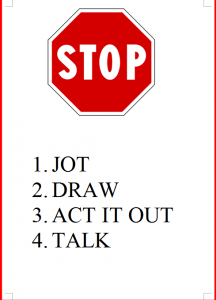There were three shifts with the Common Core:
- Use of complex text and interaction with academic language.
- Reading, writing and speaking grounded in evidence of the text.
- Increase of Non-Fiction text.
To review, when we use the term complex text we are referring to text that challenges the student and both quantitative (the mathematical reading level) and qualitative (quality of text and structure) factors have been considered. In addition, the reader, task and instructional strategies used must be considered.
With the three shifts came the controversy of whether we should be using the guided reading theory of using instructional text for small group reading or providing a more rigorous text where students needed to “grapple with the language and structure. The idea behind Guided Reading is that a teacher works with a small group of students with similar reading abilities and behaviors and provides support. The text is easy enough that students can read the text easily with the support from the teacher. The Common Core Shift opposes this idea by proposing an increase in the level of text. The Common Core Shift encourages the student to struggle with the text while the teacher adjusts instruction and strategy use (scaffolding) to ensure the child can reach text meaning.
If we think of the contrast between these two ideas—you can see the importance of the reader and the teacher which are crucial to the process of growth in reading. Knowing the reader and the strategies that they know and apply while reading can change what type of text the teacher can give the student. For example: If a child is good at figuring out context clues, the child does not require as much front loading by the teacher and the text can include more complex language.
In a research study published by the Journal of Educational Research in December 2000, researchers studied the optimal difficulty level for improving poor readers’ skills. They studied children below grade level in reading and recorded fluency (rate), word recognition, and comprehension. The readers were divided into three groups. The first group was given books at their instructional level, the second were given books two grade levels above their instructional level and the third group was given books four years above their instructional level. All of these students regardless of their group were paired with a strong and proficient reader for shared reading time fifteen minutes per day for five months.
The study found that the group paired with text two grade levels above their instructional level made the most growth and gain.
My BIG Takeaways:
- Guided Reading groups should be leveled higher than the instructional level to stretch the student since they are receiving instructional support from the teacher.
- Independent reading should be done on a text where the student has comprehension at about 80%. This allows the text to be a bit harder than is comfortable but not TOO difficult.
- Pairing a low reader with a strong reader for 15 minutes a day for shared reading can increase the students’ exposure to text and allow them to “see strategies” applied by a peer.
- Struggling readers need to be exposed to complex language structures and unknown words to be able to apply strategy independently.
My final thought from this study is that we as teachers have to be careful NOT to OVER SUPPORT! We must allow students to make mistakes, struggle and not know an answer—it is then we can help them “fix it” and learn. We must PUSH our students—ALL of them and ensure that they reach the expectation but not too easily. Think about the Goldilocks Analogy—not too hard—not too easy—JUST RIGHT! More importantly, using your knowledge as the teacher and scaffolding–keep the “carrot” dangling in front of the child. Keep the text just a bit harder than they can manage without your support!



